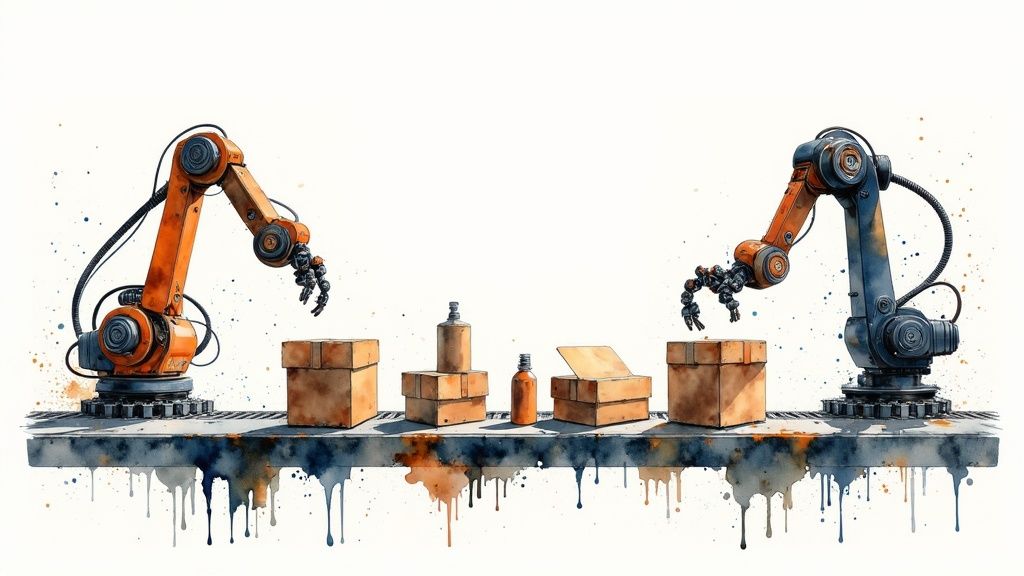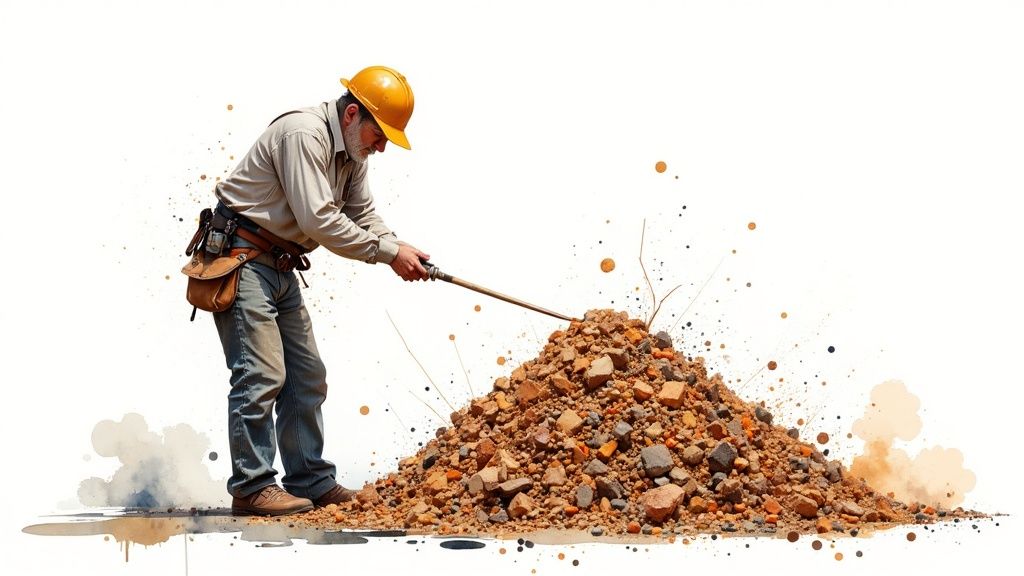Understanding Your True Production Costs
Running a successful manufacturing operation requires knowing exactly what drives your costs. Many manufacturers only look at obvious expenses like materials and labor, but the full picture includes many other factors that affect profitability.
Identifying Direct and Indirect Costs
Production costs fall into two main categories - direct costs and indirect costs. Understanding both is essential for getting an accurate view of your expenses.
-
Direct Costs: These are expenses directly linked to making your products:
- Raw materials
- Production labor
- Packaging materials
-
Indirect Costs: These support production but aren't tied to specific products:
- Factory rent/mortgage
- Utilities (electricity, water)
- Equipment maintenance
- Quality control staff
- Supervisor salaries
Let's examine how these costs typically break down in manufacturing:
| Cost Component | Typical Percentage | Reduction Potential |
|---|---|---|
| Raw Materials | 45-55% | 10-15% |
| Direct Labor | 20-30% | 5-10% |
| Factory Overhead | 15-20% | 15-20% |
| Administrative | 10-15% | 10-15% |
Cost Analysis Methods
Two key approaches can help analyze your costs in detail:
Activity-Based Costing (ABC) tracks expenses for each production activity. This shows which steps cost the most, helping identify where to focus improvement efforts.
Cost-Volume-Profit (CVP) analysis examines how production volume affects costs and profits. This helps optimize production levels for maximum profit.
For example, a furniture maker using ABC analysis discovered their finishing process had high indirect costs from ventilation and waste disposal. This led them to explore more efficient finishing methods. Similarly, research and development can drive major cost reductions. In the energy sector, work on proton exchange membrane electrolyzers cut uninstalled capital costs by 90% since 2001 and 80% since 2005. Read the full Department of Energy report
Prioritizing Cost Reduction Opportunities
After mapping out your full cost structure, focus on areas that offer the biggest potential savings. Look for:
- High-cost activities that could be streamlined
- Inefficient processes causing waste
- Opportunities to reduce material costs
- Ways to improve labor productivity
This targeted approach helps ensure your cost reduction efforts deliver maximum impact. With a clear understanding of your true costs, you can make better decisions about process improvements, resource allocation, and strategies to boost profitability.
"Harnessing Data Analytics for Smart Cost Reduction"

Getting clear on your costs is essential. But the real power comes from using data analytics to identify specific opportunities to reduce expenses. This approach helps businesses make smart, informed decisions based on real numbers rather than guesswork.
Making Data Work for You
Many factories already track basic machine performance data. By analyzing this information more deeply, they can spot hidden issues like slight drops in output from worn equipment or find the sweet spot for energy-efficient operation. The right data also helps optimize production by monitoring factors like temperature and pressure to get the best results. Learn more about manufacturing optimization.
Setting Up Smart Monitoring Systems
Good data requires good tracking systems. Focus your monitoring on Key Performance Indicators (KPIs) that directly impact costs:
- Materials: Track raw material use per unit to find waste
- Energy: Monitor power consumption to spot equipment issues and optimize usage
- Labor: Measure hours per unit to improve workflows and staffing
- Quality: Watch defect rates to reduce rework and material waste
When you analyze these numbers regularly, patterns emerge that show where you can save money. Want to learn more? Check out this guide on mastering data analytics.
Taking Action on Your Findings
Finding problems through data is just the start - you need good solutions too. Say your data shows high material waste in one production step. Ask why: Is equipment failing? Do workers need more training? Are processes inefficient? Once you know the real cause, you can fix it through maintenance, training, or better procedures.
Getting your team on board matters too. Share both the data and your planned fixes with workers. When people understand why changes are happening, they're more likely to support them and look for other ways to improve.
Building Your Game Plan
Make your cost-cutting efforts count with a clear plan:
- Set clear targets: What specific cost savings do you want?
- Choose your metrics: Which numbers will show if you're succeeding?
- Get the right tools: How will you gather and study the data?
- Plan your moves: What exact steps will fix the problems you find?
- Keep score: How will you track results and adjust your approach?
This methodical approach keeps your efforts focused on real improvements that last. With good data supporting your decisions, you can spot problems early and keep getting better over time. The key is turning raw numbers into practical changes that save money while making your operation run smoother.
Streamlining Your Production Process

Smart production management is essential for reducing costs. By looking closely at each step from materials to finished products, you can find ways to improve efficiency. Many successful manufacturers have made their operations more cost-effective by using lean manufacturing methods.
Eliminating Waste with Lean Manufacturing
Lean manufacturing focuses on removing waste while maintaining quality standards. The goal is simple - cut out activities that don't add value for customers. Here are the main types of waste to address:
- Overproduction: Making excess products creates storage costs
- Waiting: Production delays waste time and resources
- Transportation: Moving materials unnecessarily adds expenses
- Motion: Extra movement in workspaces reduces productivity
- Inventory: Keeping too much stock ties up money
- Defects: Quality issues mean costly fixes or waste
- Over-Processing: Adding steps that don't improve the product
Take a clothing factory as an example - by improving how they cut fabric patterns, they reduced material waste and saved money on supplies. For more production tips, check out How to master production capacity planning.
Optimizing Workflows and Reducing Downtime
Making workflows more efficient is another key focus. Finding and fixing bottlenecks that slow down production can make a big difference. Solutions might include better equipment or additional worker training. Regular maintenance also prevents costly breakdowns - checking machines routinely helps avoid production delays.
Automation and Technology Implementation
Automation can handle basic tasks while workers focus on more complex work. While machines often work faster and more consistently than humans, choosing automation requires careful analysis. Consider both costs and benefits before investing in new systems.
The Power of Learning Curves
The learning curve concept shows how costs typically drop as production experience grows. Workers become more skilled and processes improve over time. Many companies use the 80% progress ratio - costs decrease by 20% each time production volume doubles. For more details on reducing costs through learning curves, see this EPA resource. By using these methods together, companies can build more efficient and profitable production systems.
Empowering Your Team to Drive Cost Reduction

The most effective cost reduction efforts come from engaging your entire workforce, not just issuing top-down directives. When manufacturers actively involve their teams in finding savings opportunities, they often discover valuable insights while building a stronger company culture.
Building a Cost-Conscious Culture
Good communication forms the foundation of cost awareness. Share your company's financial goals openly and help employees understand how production costs affect business success. Regular updates on cost-saving wins, like a team finding ways to reduce material waste, can inspire others to spot similar opportunities.
Getting workers involved in cost reduction creates real ownership of outcomes. When team members feel their ideas matter, they're more likely to embrace changes and participate in improvement programs. Learn more about improving manufacturing efficiency
Effective Training Programs
Give your team practical skills to identify and tackle cost-saving projects. Key training areas should include:
- Process optimization methods
- Waste reduction techniques
- Basic financial concepts
- Problem-solving approaches
This knowledge investment pays off as employees gain confidence in spotting improvement opportunities and understanding their financial impact.
Incentive Systems That Work
While encouragement matters, concrete rewards drive stronger results. Consider offering:
- Performance bonuses tied to cost savings
- Recognition programs highlighting team and individual wins
- Balanced incentives that promote both personal and group achievements
The key is designing rewards that encourage teamwork rather than unhealthy competition. This keeps everyone focused on overall company success.
Suggestion Programs and Innovation
Set up simple ways for employees to share their cost-saving ideas. The people doing the work often have the best insights into potential improvements. Make sure your suggestion system:
- Is easy to use
- Provides quick feedback
- Celebrates implemented ideas
- Encourages ongoing participation
When you combine a cost-aware culture, solid training, smart incentives, and open channels for ideas, your team becomes a powerful force for finding savings. This creates lasting positive change while strengthening your bottom line through their collective knowledge and creativity.
Mastering Supply Chain Cost Optimization

Smart supply chain management can dramatically reduce production costs. By looking at how materials move from suppliers to finished products, manufacturers can build more efficient and cost-effective operations. This section shows practical ways leading companies optimize their supply chains.
Building Strong Supplier Relationships
Good supplier partnerships rest on open communication and shared goals. Regular meetings and joint improvement projects help both sides find cost savings. A supplier might suggest an alternative material that works just as well but costs less. These collaborative relationships often lead to meaningful savings for manufacturers and suppliers alike.
Strategic Sourcing and Negotiation
When choosing suppliers, look beyond just price. Strategic sourcing means evaluating quality, reliability, and innovation capabilities. Smart contract negotiation covers pricing, payment terms, and volume discounts while maintaining quality standards. Having clear agreements protects both parties and keeps costs predictable.
Inventory Management for Cost Reduction
Extra inventory wastes money through storage costs and tied-up capital. A good inventory management system uses accurate forecasting and lean ordering processes. Many companies use Just-in-Time delivery to minimize storage needs. This requires careful planning with suppliers to prevent shortages.
Bulk Purchasing Strategies
Buying larger quantities often reduces per-unit costs, but requires careful analysis. Consider your storage space, product shelf life, and cash flow needs. This approach works best for stable items you use regularly. For instance, food makers might buy common ingredients like sugar in bulk to save money while ensuring steady supply.
Logistics Optimization
Logistics covers moving materials and products through your supply chain. Better transport routes, warehousing, and delivery methods cut costs. Companies save money by combining shipments, choosing cost-effective carriers, and using technology to track deliveries. Small changes in warehouse layout can speed up processing times.
Comparing Supply Chain Optimization Strategies
Let's compare different ways to optimize your supply chain costs:
| Strategy | Implementation Cost | Potential Savings | Timeline |
|---|---|---|---|
| Supplier Partnerships | Low | Medium | Short-Medium |
| Strategic Sourcing | Medium | High | Medium-Long |
| Inventory Optimization | Medium | High | Short-Medium |
| Bulk Purchasing | Low | Medium | Short |
| Logistics Optimization | Medium | High | Medium-Long |
A well-planned supply chain strategy gives manufacturers an edge over competitors. By focusing on these key areas, companies can reduce costs while keeping quality high. Remember that supply chain improvement needs ongoing attention - it's not a one-time fix but a continuous process of finding better ways to work.
Sustaining Your Cost Reduction Success
Making production costs lower isn't a one-time fix - it requires ongoing attention and effort. The real work begins after those initial wins, when you need to keep the momentum going and make cost management part of your company's DNA. Success comes from having clear processes, keeping track of progress, and getting everyone involved.
Building a System for Continuous Improvement
Like maintaining a healthy lifestyle, keeping costs down needs good daily habits, not quick fixes. Start by setting clear Key Performance Indicators (KPIs) and checking them regularly. Watch your cost data closely to spot any concerning trends early - this helps catch small issues before they become expensive problems.
Say you notice material waste starting to creep up. Take time to dig into why - is it equipment issues, changes in materials from suppliers, or do staff need a refresher on best practices? Finding and fixing root causes helps lock in your savings for the long run.
Adapting to New Challenges
Business conditions and technologies keep changing, bringing fresh challenges. Your cost-saving approach needs to stay flexible. Keep up with what works well in your industry and be ready to adjust your methods. Maybe there's new automation tech that could help, or changes in supplier options that could reduce costs. Staying open to improvements helps maintain success.
Engaging Stakeholders for Long-Term Success
Cost reduction works best when everyone's on board. When employees understand how their work affects the bottom line, they'll naturally look for ways to save money. This builds a company culture where everyone thinks about smart spending.
Keep communication flowing - share wins and recognize both team and individual contributions. This reinforces why cost management matters and keeps people motivated to participate. You might be interested in: How to master proven ecommerce conversion rate optimization tactics.
Overcoming Common Obstacles
You'll likely face some roadblocks - people resisting changes, lack of buy-in, or trouble measuring results. Success requires strong leadership, clear messages about goals and progress, and making sure teams have the training and tools they need.
Scaling Successful Initiatives
When cost-saving methods work well in one area, look for ways to expand them to other parts of your business. This multiplies your savings across the organization. Write down what works and create standard steps to follow - this makes it easier to roll out successful approaches consistently.
By building solid improvement systems, getting your team involved, handling new challenges well, and growing what works, you can turn short-term wins into lasting gains that keep your business competitive and profitable.
Ready to make your video content creation more efficient while managing costs? See how Aeon's AI-powered platform can improve your production process and results. Learn more about Aeon.